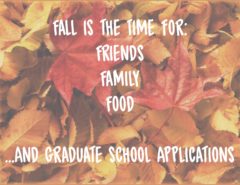By: Abraham Inouye
It’s not about what you know, it’s who you know. This piece of advice proved invaluable on a recent trip to attend an IFT conference in Washington D.C. This article is a summary of the 10 most important lessons I learned on my recent networking adventure.
1. Spend sufficient time, effort, and money on networking.
Sure, networking can be expensive (traveling, conference fees, taking people out to dinner, etc.), but so is a $60,000 graduate degree without a job offer. Invest in your future employment.
2. Do your homework before you meet people.
You would never take a test without preparing. Likewise, never contact someone with the requisite amount of preparation. Know their background, what they have written about, what company do they work for, etc.
3. Know what to say and what not to say.
When you do contact someone, follow the networking etiquette. What to say: I am a student, I have read about your work and find it fascinating, and I would appreciate some advice. What not to say: I am a student and I want you to give me a job.
4. Take advantage of conferences.
Conferences are great. The information at conferences is always up-to-date, there are a wide variety of topics, and all of these famous/smart/interesting speakers are all in one room and you have an opportunity to talk to each one of them.
5. Set up mini-meetings at the conference.
Conferences are very busy and sometimes it is hard to find time to meet with a speaker. Solve this problem by e-mailing them beforehand. Introduce yourself as an interested student, and ask for a short, face-to-face introduction at the conference.
6. Have a presentable business card to trade.
The exchanging of business cards is an important networking ritual. Have a professional-looking card so you can participate in this ritual. Also, business cards are the perfect place to jot down notes about the person you just met.
7. Talk to everyone.
No really, talk to everyone. That includes the speakers that you scouted in advance, the people on the attendance list who look interesting to you, everyone at your table, and anyone you meet during the break times. Don’t forget to meet the conference staff as well—not only are they fun, interesting people who just planned a great conference for you, but they also know everyone in attendance and can help you meet them if you need it.
8. Take notes on people you meet.
After your head-spinning networking event, the work is not done yet. Take every business card you collected and make notes about who that person was, what you talked about, any advice they gave you, and whether or not you should follow up with them.
9. Follow up with a short email.
Shortly after meeting someone, follow-up with an email. Keep it simple: Hi, my name is ____. I enjoyed meeting you at ___ Conference. I especially appreciate your advice about ____. I want to act on your advice. Would you be able to help me ____. Thank you again and I look forward to hearing from you.”
10. Have the right attitude.
Having practiced as an attorney for a short time before going back to school, it is easier for me to see myself as a future colleague of the people I am trying to network with, rather than just a student. However, never forget to show gratitude when someone takes the time to network with you. Always be sincere and considerate.
In conclusion, networking is a skill that can be quickly and easily learned; however, it requires patience. Seeds planted today may only begin to yield fruit months, even years later—so start planting those seeds today.
Photo credit: http://blog.ivyexec.com/wp-content/uploads/2012/12/Networking.jpg






Great article! I think numbers 8 and 9 are crucial! It’s important to take notes, so you can remember what you talked about with each person and then to follow up. I’ve gotten home from a conference before with a bunch of business cards and found myself trying to remember who it was that I talked about each topic with. Use the blank back of the business card!!
Thanks Emily. I am torn between writing things on the backs of cards, or writing a longer note to myself on my phone. But you’re right, the sooner you write things down, the more you will be able to remember. Hope to meet you at a conference some day.
Great point. I think writing on the back of the card is a good starting point to remember main topics discussed with each person. But, if you had a particularly interesting/in-depth conversation with someone, writing a longer note on your phone or whatnot would be a great way to follow up in more detail.
If you have an iPhone, I’ve been using this app called camcard, you take a picture of the person’s business card and it creates the contact right in your phone…in case you’re like me and either lose business cards or get tired of carrying them in your wallet. Great points, Abraham.